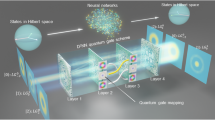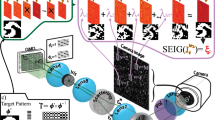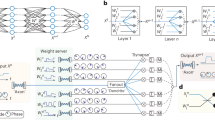Abstract
Diffraction drastically limits the bit density in optical data storage. To increase the storage density, alternative strategies involving supplementary recording dimensions and robust readout schemes must be explored. Here, we propose to encode multiple bits of information in the geometry of subwavelength dielectric nanostructures. A crucial problem in high-density information storage concepts is the robustness of the information readout with respect to fabrication errors and experimental noise. Using a machine-learning-based approach in which the scattering spectra are analysed by an artificial neural network, we achieve quasi-error-free readout of sequences of up to 9 bits, encoded in top-down fabricated silicon nanostructures. We demonstrate that probing few wavelengths instead of the entire spectrum is sufficient for robust information retrieval and that the readout can be further simplified, exploiting the RGB values from microscopy images. Our work paves the way towards high-density optical information storage using planar silicon nanostructures, compatible with mass-production-ready complementary metal–oxide–semiconductor technology.
This is a preview of subscription content, access via your institution
Access options
Access Nature and 54 other Nature Portfolio journals
Get Nature+, our best-value online-access subscription
$29.99 / 30 days
cancel any time
Subscribe to this journal
Receive 12 print issues and online access
$259.00 per year
only $21.58 per issue
Buy this article
- Purchase on Springer Link
- Instant access to full article PDF
Prices may be subject to local taxes which are calculated during checkout






Similar content being viewed by others
Code availability
The authors declare that all software used to obtain the results of this work is publicly accessible as open-source software: python including SciPy, TensorFlow, as well as pyGDM46, our own implementation of the GDM. Our scripts can be made accessible from the corresponding author upon reasonable request.
Data availability
The data that support the plots within this paper and other findings of this study are available from the corresponding author upon reasonable request. The experimental and simulated scattering data sets are available under https://doi.org/10.6084/m9.figshare.7326842.v1.
References
Zhang, J., Gecevičius, M., Beresna, M. & Kazansky, P. G. Seemingly unlimited lifetime data storage in nanostructured glass. Phys. Rev. Lett. 112, 033901 (2014).
Gu, M., Li, X. & Cao, Y. Optical storage arrays: a perspective for future big data storage. Light Sci. Appl. 3, e177 (2014).
Satoh, I., Ohara, S., Akahira, N. & Takenaga, M. Key technology for high density rewritable DVD (DVD-RAM). IEEE Trans. Magn. 34, 337–342 (1998).
Borg, H. J. et al. Phase-change media for high-numerical-aperture and blue-wavelength recording. Jpn J. Appl. Phys. 40, 1592 (2001).
Zeng, B. J., Ni, R. W., Huang, J. Z., Li, Z. & Miao, X. S. Polarization-based multiple-bit optical data storage. J. Opt. 16, 125402 (2014).
Tominaga, J., Nakano, T. & Atoda, N. An approach for recording and readout beyond the diffraction limit with an Sb thin film. Appl. Phys. Lett. 73, 2078–2080 (1998).
Mottaghi, M. D. & Dwyer, C. Thousand-fold increase in optical storage density by polychromatic address multiplexing on self-assembled DNA nanostructures. Adv. Mater. 25, 3593–3598 (2013).
Strickler, J. H. & Webb, W. W. Three-dimensional optical data storage in refractive media by two-photon point excitation. Opt. Lett. 16, 1780–1782 (1991).
van Heerden, P. J. Theory of optical information storage in solids. Appl. Opt. 2, 393–400 (1963).
Psaltis, D. & Burr, G. W. Holographic data storage. Computer 31, 52–60 (1998).
Girard, C. Near fields in nanostructures. Rep. Prog. Phys. 68, 1883–1933 (2005).
Novotny, L. & Hecht, B. Principles of Nano-Optics (Cambridge Univ. Press, Cambridge, 2006).
Maier, S. Plasmonics: Fundamentals and Applications (Springer, New York, 2010).
Kuznetsov, A. I. et al. Optically resonant dielectric nanostructures. Science 354, aag2472 (2016).
Cao, L., Fan, P., Barnard, E. S., Brown, A. M. & Brongersma, M. L. Tuning the color of silicon nanostructures. Nano Lett. 10, 2649–2654 (2010).
Wiecha, P. R. et al. Evolutionary multi-objective optimization of colour pixels based on dielectric nanoantennas. Nat. Nanotechnol. 12, 163–169 (2017).
Mansuripur, M. et al. Plasmonic nano-structures for optical data storage. Opt. Express 17, 14001–14014 (2009).
Chen, W. T. et al. Manipulation of multidimensional plasmonic spectra for information storage. Appl. Phys. Lett. 98, 171106 (2011).
Cui, Y., Phang, I. Y., Hegde, R. S., Lee, Y. H. & Ling, X. Y. Plasmonic silver nanowire structures for two-dimensional multiple-digit molecular data storage application. ACS Photon. 1, 631–637 (2014).
El-Rabiaey, M. A., Areed, N. F. F. & Obayya, S. S. A. Novel plasmonic data storage based on nematic liquid crystal layers. J. Lightwave Technol. 34, 3726–3732 (2016).
Zijlstra, P., Chon, J. W. M. & Gu, M. Five-dimensional optical recording mediated by surface plasmons in gold nanorods. Nature 459, 410–413 (2009).
Taylor, A. B., Kim, J. & Chon, J. W. M. Detuned surface plasmon resonance scattering of gold nanorods for continuous wave multilayered optical recording and readout. Opt. Express 20, 5069–5081 (2012).
Taylor, A. B., Michaux, P., Mohsin, A. S. M. & Chon, J. W. M. Electron-beam lithography of plasmonic nanorod arrays for multilayered optical storage. Opt. Express 22, 13234–13243 (2014).
Li, X., Cao, Y., Tian, N., Fu, L. & Gu, M. Multifocal optical nanoscopy for big data recording at 30 TB capacity and gigabits/second data rate. Optica 2, 567–570 (2015).
Liu, D., Tan, Y., Khoram, E. & Yu, Z. Training deep neural networks for the inverse design of nanophotonic structures. ACS Photon. 5, 1365–1369 (2018).
Albella, P. et al. Low-loss electric and magnetic field-enhanced spectroscopy with subwavelength silicon dimers. J. Phys. Chem. C 117, 13573–13584 (2013).
Nielsen, M. A. Neural Networks and Deep Learning (Determination Press, 2015); http://neuralnetworksanddeeplearning.com/
Goodfellow, I., Bengio, Y. & Courville, A. Deep Learning (MIT Press, Cambridge, 2016).
Szegedy, C., Ioffe, S., Vanhoucke, V. & Alemi, A. Inception-v4, inception-ResNet and the impact of residual connections on learning. Preprint at https://arxiv.org/abs/1602.07261 (2016).
Mamoshina, P., Vieira, A., Putin, E. & Zhavoronkov, A. Applications of deep learning in biomedicine. Mol. Pharm. 13, 1445–1454 (2016).
Shimobaba, T. et al. Convolutional neural network-based data page classification for holographic memory. Appl. Opt. 56, 7327–7330 (2017).
Jo, Y. et al. Holographic deep learning for rapid optical screening of anthrax spores. Sci. Adv. 3, e1700606 (2017).
Malkiel, I. et al. Plasmonic nanostructure design and characterization via deep learning. Light Sci. Appl. 7, 60 (2018).
Peurifoy, J. et al. Nanophotonic particle simulation and inverse design using artificial neural networks. Sci. Adv. 4, eaar4206 (2018).
van der Maaten, L. & Hinton, G. Visualizing high-dimensional data using t-SNE. J. Mach. Learn. Res. 9, 2579–2605 (2008).
Feichtner, T., Selig, O., Kiunke, M. & Hecht, B. Evolutionary optimization of optical antennas. Phys. Rev. Lett. 109, 127701 (2012).
Rivenson, Y. et al. Deep learning enhanced mobile-phone microscopy. ACS Photon. 5, 2354–2364 (2018).
Orth, A., Wilson, E. R., Thompson, J. G. & Gibson, B. C. A dual-mode mobile phone microscope using the onboard camera flash and ambient light. Sci. Rep. 8, 3298 (2018).
Wei, Q. et al. Plasmonics enhanced smartphone fluorescence microscopy. Sci. Rep. 7, 2124 (2017).
Flauraud, V., Reyes, M., Paniagua-Domínguez, R., Kuznetsov, A. I. & Brugger, J. Silicon nanostructures for bright field full color prints. ACS Photon. 4, 1913–1919 (2017).
González-Alcalde, A. K. et al. Optimization of all-dielectric structures for color generation. Appl. Opt. 57, 3959–3967 (2018).
Duan, X., Kamin, S. & Liu, N. Dynamic plasmonic colour display. Nat. Commun. 8, 14606 (2017).
Guerfi, Y., Carcenac, F. & Larrieu, G. High resolution HSQ nanopillar arrays with low energy electron beam lithography. Microelectron. Eng. 110, 173–176 (2013).
Guerfi, Y., Doucet, J. B. & Larrieu, G. Thin-dielectric-layer engineering for 3D nanostructure integration using an innovative planarization approach. Nanotechnology 26, 425302 (2015).
Martin, O. J. F., Girard, C. & Dereux, A. Generalized field propagator for electromagnetic scattering and light confinement. Phys. Rev. Lett. 74, 526–529 (1995).
Wiecha, P. R. pyGDM—a python toolkit for full-field electro-dynamical simulations and evolutionary optimization of nanostructures. Comput. Phys. Commun. 233, 167–192 (2018).
Girard, C., Dujardin, E., Baffou, G. & Quidant, R. Shaping and manipulation of light fields with bottom-up plasmonic structures. New J. Phys. 10, 105016 (2008).
Edwards, D. F. In Handbook of Optical Constants of Solids (ed. Palik, E. D.) 547–569 (Academic, Burlington, 1997).
Draine, B. T. The discrete-dipole approximation and its application to interstellar graphite grains. Astrophys. J. 333, 848–872 (1988).
Abadi, M. et al. TensorFlow: Large-scale Machine Learning on Heterogeneous Distributed Systems. https://www.tensorflow.org/ (2015).
Ioffe, S. & Szegedy, C. Batch normalization: accelerating deep network training by reducing internal covariate shift. Preprint at https://arxiv.org/abs/1502.03167 (2015).
Kingma, D. P. & Ba, J. Adam: a method for stochastic optimization. Preprint at https://arxiv.org/abs/1412.6980 (2014).
Acknowledgements
The authors thank A. Arbouet and C. Girard for their advice, for their help and for discussing and proofreading the manuscript, and F. Carcenac for his help with EBL and automatic SEM images. This work was supported by Programme Investissements d’Avenir under the program ANR-11-IDEX-0002-02, reference ANR-10-LABX-0037-NEXT, by the LAAS-CNRS micro and nanotechnologies platform, a member of the French RENATECH network, and by the computing facility centre CALMIP of the University of Toulouse under grant P12167.
Author information
Authors and Affiliations
Contributions
P.R.W. conceived the idea and designed the research together with G.L. G.L. and A.L. developed the fabrication techniques. A.L. fabricated the nanostructures and performed the electron microscopy with the help of N.M. P.R.W. carried out the optical experiments, did the simulations and the data analysis, and implemented the machine-learning part. P.R.W. wrote the manuscript with contributions from G.L. P.R.W and G.L. discussed the results and all authors commented on the manuscript at every stage.
Corresponding author
Ethics declarations
Competing interests
The authors declare no competing interests.
Additional information
Publisher’s note: Springer Nature remains neutral with regard to jurisdictional claims in published maps and institutional affiliations.
Supplementary information
Rights and permissions
About this article
Cite this article
Wiecha, P.R., Lecestre, A., Mallet, N. et al. Pushing the limits of optical information storage using deep learning. Nat. Nanotechnol. 14, 237–244 (2019). https://doi.org/10.1038/s41565-018-0346-1
Received:
Accepted:
Published:
Issue Date:
DOI: https://doi.org/10.1038/s41565-018-0346-1
This article is cited by
-
Perovskite single-pixel detector for dual-color metasurface imaging recognition in complex environment
Light: Science & Applications (2023)
-
Multimodal dynamic and unclonable anti-counterfeiting using robust diamond microparticles on heterogeneous substrate
Nature Communications (2023)
-
Versatile full-colour nanopainting enabled by a pixelated plasmonic metasurface
Nature Nanotechnology (2023)
-
Design of highly perceptible dual-resonance all-dielectric metasurface colorimetric sensor via deep neural networks
Scientific Reports (2022)
-
Machine-learning-driven on-demand design of phononic beams
Science China Physics, Mechanics & Astronomy (2022)



